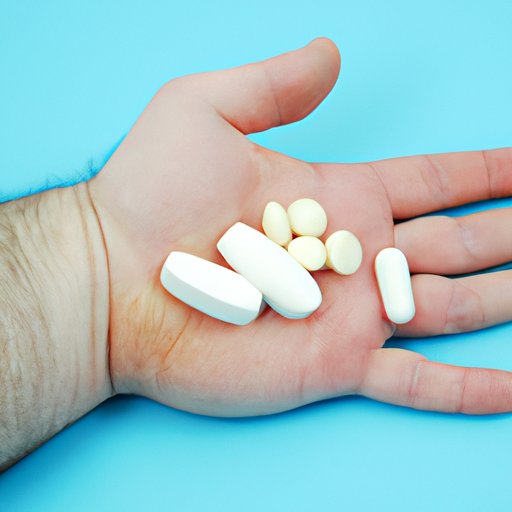
Introduction
Arthritis is a chronic condition characterized by inflammation and pain in the joints. It affects millions of adults worldwide and can significantly impact their daily activities and quality of life. Seeking proper treatment is crucial in managing symptoms and preventing further joint damage. That’s why we’ve created this guide to teach you about the different ways to treat arthritis and improve your joint health at the same time.
Medications
One of the most common methods of treating arthritis is through medication. There are several types of drugs that doctors may prescribe, including nonsteroidal anti-inflammatory drugs (NSAIDs), corticosteroids, and disease-modifying antirheumatic drugs (DMARDs).
NSAIDs work by reducing inflammation in the joints, which can help relieve pain and stiffness. Commonly prescribed NSAIDs include ibuprofen, naproxen, and aspirin. However, long-term use of NSAIDs can lead to side effects such as stomach ulcers, bleeding, and kidney problems.
Corticosteroids are a stronger type of anti-inflammatory drug that can be taken orally or injected directly into the joint. While they can provide fast relief, they also come with a higher risk of side effects, such as weight gain, mood changes, and weakening of bones.
DMARDs are used to slow down or stop the progression of arthritis. They work by suppressing the immune system, which can reduce inflammation in the joints. These drugs can take several weeks or even months to take effect, but they have a lower risk of side effects.
Exercise
Exercise is an essential aspect of managing arthritis symptoms. Regular physical activity can strengthen the muscles surrounding the joint and improve range of motion, making it easier to perform daily tasks. Additionally, exercise can promote weight loss, which can reduce the amount of pressure placed on the joints.
Low-impact activities like walking, swimming, and cycling are ideal for people with arthritis. These activities are gentle on the joints while still providing a good workout. Stretching exercises and yoga can also be beneficial in improving flexibility and reducing pain.
Diet
Studies have shown that certain foods can help reduce inflammation in the body, which can alleviate arthritis symptoms. These foods include fatty fish like salmon, nuts and seeds, fruits and vegetables, and whole grains.
Additionally, maintaining a healthy diet can improve overall joint health by preventing obesity and reducing the risk of other conditions that can worsen arthritis, such as type 2 diabetes and heart disease. Some supplements like turmeric and omega-3 fatty acids may also be helpful in reducing inflammation and pain.
Acupuncture
Acupuncture is an alternative therapy that involves inserting thin needles into specific points on the body. It is believed to stimulate the body’s natural healing processes and reduce pain. Studies have found that acupuncture may be helpful in reducing arthritis pain and improving joint function.
During an acupuncture session, the practitioner may ask you to lie down or sit comfortably while they insert the needles. They may also apply heat or electrical stimulation to the needles to enhance their effect. While acupuncture is generally considered safe, it can come with some risks, including infection and bleeding.
Surgery
In cases of severe arthritis, surgery may be necessary to repair or replace damaged joints. Types of surgery for arthritis can include joint fusion, joint replacement, and arthroscopy. Recovery time can vary depending on the type of surgery and the joint being operated on.
Prior to surgery, your doctor will perform a thorough evaluation to determine if surgery is the best course of treatment. They may also recommend other treatments, such as physical therapy or medication, to manage your symptoms.
Hot and Cold Therapies
Applying heat or cold to affected joints can be a simple and effective way to reduce pain and inflammation. Warm baths, hot compresses, and heating pads can help relax muscles and increase circulation, which can alleviate pain and stiffness in the joints.
On the other hand, cold compresses or ice packs can help reduce inflammation and swelling. You can use a bag of frozen vegetables, a cold pack, or even a bag of ice wrapped in a towel to apply cold therapy.
Alternative Therapies
In addition to traditional Western medicine, there are also alternative therapies that may be helpful in managing arthritis symptoms. Some of these treatments include massage, acupuncture, aromatherapy, and chiropractic care.
While these therapies may not be supported by as much scientific evidence as medication or surgery, many people with arthritis have found them to be helpful in reducing pain, improving mobility, and promoting relaxation. However, it’s important to speak with your doctor before trying any alternative therapies to ensure they are safe and won’t interfere with other treatments.
Conclusion
Arthritis is a challenging condition, but with proper treatment, it is possible to improve joint health and alleviate symptoms. A combination of medication, exercise, and a healthy diet can go a long way in managing the condition and promoting overall wellness. Don’t be afraid to explore alternative therapies as well, but always consult with your doctor first. By working closely with your healthcare team, you can find the right combination of treatments to help you lead a full and active life.




